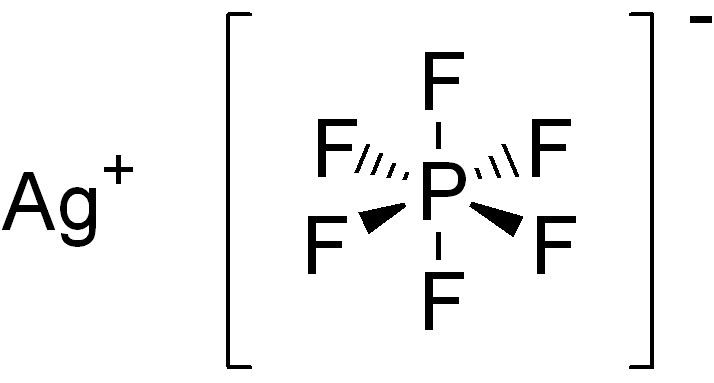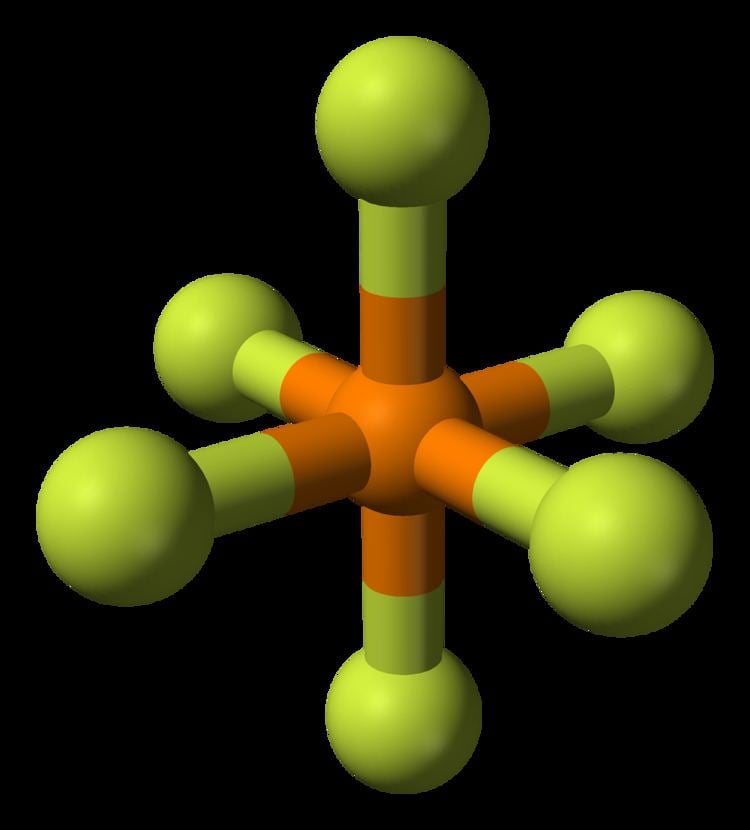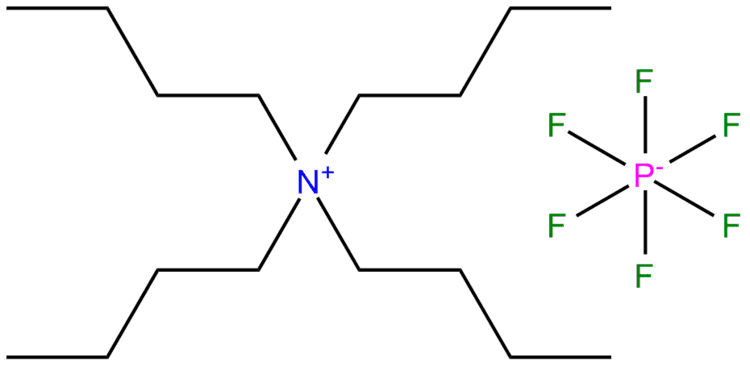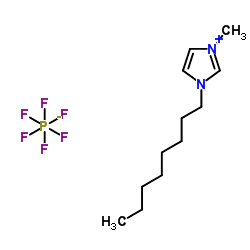Formula F6P- | Molar mass 144.9642 g/mol | |
 | ||
Hexafluorophosphate ion pf6 lewis dot structure
Hexafluorophosphate is an anion with chemical formula of PF−
6. This octahedral species is isoelectronic with sulfur hexafluoride, SF6, and the hexafluorosilicate dianion, SiF62−, and is valence isoelectronic with the highly stable superacid anion fluoroantimonate SbF−
6. As a non-coordinating anion, it is a poor nucleophile. It is prone to decomposition with the release of hydrogen fluoride in ionic liquids but is generally extremely stable in solution. Hydrolysis to the phosphate ion is very slow even in concentrated acid with warming, and even slower under basic conditions.
Contents
- Hexafluorophosphate ion pf6 lewis dot structure
- Pf6 lewis structure how to draw the lewis structure for hexafluorophosphate
- Synthesis
- Quantitative analysis
- Properties
- Applications
- Secondary batteries
- Organometallic synthesis
- Ionic liquids
- Inorganic synthesis
- References

Pf6 lewis structure how to draw the lewis structure for hexafluorophosphate
Synthesis

Hexafluorophosphate salts can be prepared by the reaction of phosphorus pentachloride and alkali or ammonium halide in a solution of hydrofluoric acid:
PCl5 + MCl + 6 HF → MPF6 + 6 HCl
Hexafluorophosphoric acid can be prepared by direct reaction of hydrogen fluoride with phosphorus pentafluoride. It is a strong Brønsted acid that is typically generated in situ immediately prior to its use.
PF5 + HF → HPF6
These reactions require specialized equipment to safely handle the hazards associated with hydrofluoric acid solution and hydrogen fluoride gas.
Quantitative analysis

Quantitative analysis is an area of analytical chemistry used to determine the amount of a species present in a sample. Several methods of quantitative analysis for the hexafluorophosphate ion have been developed. Tetraphenylarsonium chloride, [(C6H5)4As]Cl, has been used both for titrimetric and gravimetric quantifications of hexafluorophosphate. Both of these determinations depend on the formation of tetraphenylarsonium hexafluorophosphate:
[(C6H5)4As]+ + PF6− → [(C6H5)4As]PF6Hexafluorophosphate can also be determined spectrophotometrically with ferroin.
Properties

Non-coordinating anions are anions that interact only weakly with cations, a useful property when studying highly electrophilic cations. In coordination chemistry, the term can also be used to refer to anions which are unlikely to bind directly to the metal centre of a complex. Hexafluorophosphate is a non-coordinating anion in both senses of the term. Three widely used non-coordinating anions are hexafluorophosphate, tetrafluoroborate BF−
4, and perchlorate ClO−
4; of these, the hexafluorophosphate ion has the least coordinating ability and it is deliberately used for this property. In the 1990s, a new non-coordinating anion, [B[3,5-(CF3)2C6H3]4]− commonly abbreviated as [BArF4]− and colloquially known as "BARF" was discovered; BARF is far less coordinating than hexafluorophosphate.
Applications

Practical uses of the hexafluorophosphate ion typically exploit one or more of the following properties: that it is a non-coordinating anion; that hexafluorophosphate compounds are typically soluble in organic solvents, particularly polar ones, but have low solubility in aqueous solution; or, that it has a high degree of stability, including resistance to both acidic and basic hydrolysis.
Secondary batteries

The main commercial use of hexafluorophosphate is as its lithium salt, lithium hexafluorophosphate. This salt, in combination with dimethyl carbonate, is a common electrolyte in commercial secondary batteries such as lithium-ion cells. This application exploits the high solubility of hexafluorophosphate salts in organic solvents and the resistance of these salts to reduction by the alkali metal cathode. Since the lithium ions in these batteries are generally present as coordination complexes within the electrolyte, the non-coordinating nature of the hexafluorophosphate ion is also a useful property for these applications.
Organometallic synthesis
Hexafluorophosphate salts are often included in organometallic syntheses to provide an inert and non-coordinating counterion. Tetrafluoroborate salts are a common alternative choice. One route to such compounds involves reactions with silver hexafluorophosphate with the halide salt. Precipitation of insoluble silver halide salt helps drive this reaction to completion. Since hexafluorophosphate salts are often insoluble in water but soluble in polar organic solvents, even the addition of ammonium hexafluorophosphate (NH4PF6) to aqueous solutions of many organic and inorganic salts gives solid precipitates of hexafluorophosphate salts. This method can have advantages over the silver hexafluorophosphate method in terms of expense and in systems where contamination with metal ions is strongly discouraged. As an example, the microwave synthesis of rhodicinium hexafluorophosphate involves the reaction of cyclopentadiene and rhodium(III) chloride hydrate in methanol. During the workup with methanolic ammonium hexafluorophosphate the product salt precipitates cleanly from the reaction mixture. The overall conversion equation is
RhCl3.xH2O + 2 C5H6 + NH4PF6 → [(η5-C5H5)2Rh]PF6(s) + 2 HCl + NH4Cl + xH2OWhilst the hexafluorophosphate ion is generally considered inert and hence a suitable counterion, solvolysis reactions of the hexafluorophosphate ion are known. For example, the tris(solvent) rhodium complex [(η5-C5Me5)Rh(Me2CO)3](PF6)2 undergoes solvolysis when heated in acetone, forming a difluorophosphate-bridged complex [(η5-C5Me5)Rh(μ-OPF2O)3Rh(η5-C5Me5)]PF6.
Ionic liquids
Hexafluorophosphate organic salts that are soluble in organic solvents and ionic liquids are well known. The routes to such compounds are similar to those used for organometallic salts, such as anion exchange from the halide salt with silver hexafluorophosphate or use of ammonium hexafluorophosphate. Room temperature ionic liquids such as 1-butyl-3-methylimidazolium hexafluorophosphate (typically abbreviated as bmimPF6) have been prepared. The advantage of the anion exchange in favour of a non-coordinating anion is that the resulting ionic liquid has much higher thermally stability. The reason is that the possibility of decomposition of the imidazolium cation is decreased; 1-butyl-3-methylimidazolium chloride could decompose to N-methylimidazole and 1-chlorobutane or to N-butylimidazole and chloromethane. Such decompositions are not possible for bmimPF6 However, thermal decompositions of hexafluorophosphate ionic liquids to generate hydrogen fluoride gas are known.
Inorganic synthesis
The hexafluorophosphate ion, being a large anion, can be useful in stabilising large cations. In the compound tetrakis(acetonitrile)copper(I) hexafluorophosphate, [Cu(CH3CN)4]PF6, the acetonitrile ligands protect the copper(I) centre from oxidation to copper(II);‹See TfD› combined with the lability of the complex, this makes for a suitable precursor in the non-aqueous syntheses of copper(I) compounds. However, the nearly linear arrangement of the 'arms' of this tetrahedral cation makes for a high degree of bulk. Consequently, the inclusion of a bulky counterion has a stabilising effect and a non-coordinating anion like hexafluorophosphate is ideal given the lability. The compound can be produced by the addition of hexafluorophosphoric acid to a suspension of copper(I) oxide in acetonitrile:
Cu2O + 2 HPF6 + 8 CH3CN → 2 [Cu(CH3CN)4]PF6 + H2O